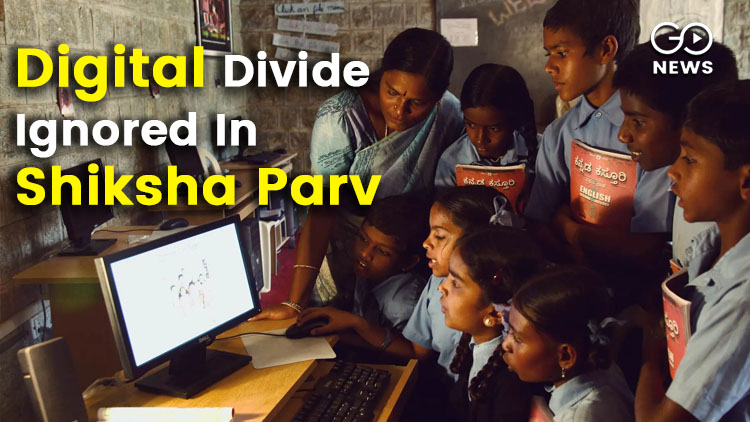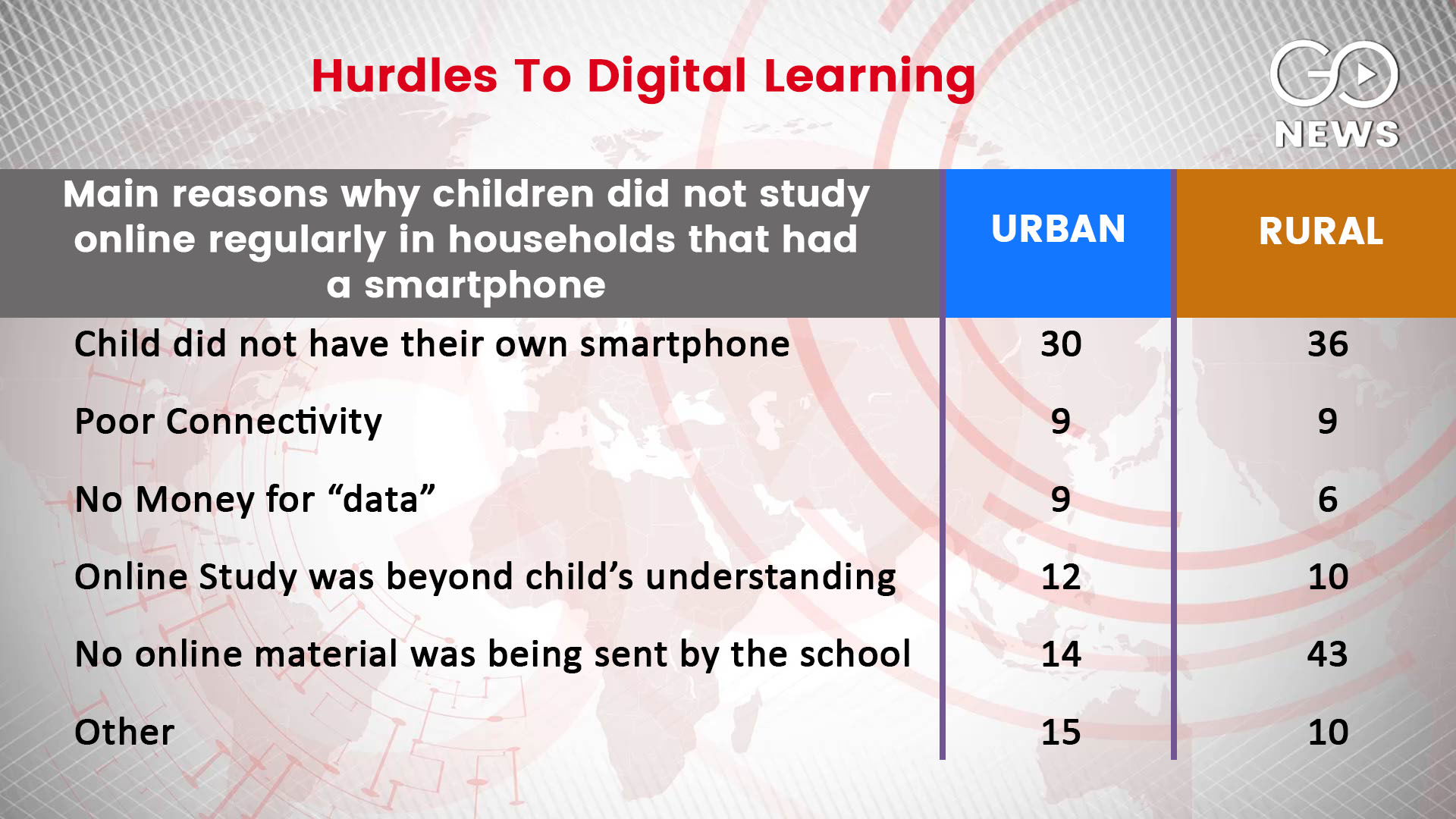Digital Divide, Poor Learning Outcomes Despite 'Digital India'
ASER is an organization that measures educational outcome and impact of policies on the country. It has reported that 43% of rural and 36% of urban parents did not have smartphones that their children could use. In the households that cross the barrier of access to devices, 30% in urban and 36% in rural household did not have separate smartphone for children.

During the ‘Shiksha Parv’ organized virtually on September 7, Prime Minister Narendra Modi urged the private sector to participate in improving the quality of government schools. His announcements are being presented as significant ‘initiatives’ in the education field by the media. The theme of this year’s ‘Shikshak Parv’ 2021 was Quality and Sustainable Schools.
At the event, the Prime Minister announced that he had asked Olympians and Paralympians to tour 75 schools to mark “Azadi Ka Amrit Mahotsav”. Int his event he also launched a dictionary for Indian Sign Language, in the context of which he said: “Education should not only be inclusive but also be equitable”.
This is a good step towards bringing specially abled children into the fold of mainstream education. However, there is another pressing issue, the digital divide, which continues to hinder the objectives of a truly inclusive educational system. There is a growing gap between private and publicly funded education, and digital media such as online coaching platforms are mostly accessible to a demographic of urban, English-speaking, and economically advantaged families and their children. ASER is an organization that measures educational outcome and impact of policies on the country. It has reported that 43% of rural and 36% of urban parents did not have smartphones that their children could use. In the households that cross the barrier of access to devices, 30% in urban and 36% in rural household did not have separate smartphone for children. It is also significant to note that while primary school enrolment rates in India are high (96% in 2019 according to World Bank), the learning outcomes are clearly not keeping pace with the intake, indicating a lack of quality and infrastructure in schools.
According to the ASER report it has been seen the percentage of Class 5 children who can read a Class2 level text was 45.7% in 2014, and this dropped to 41.9% in 2016. It was 47.6% in 2018 and 32.8% in 2020. This shows that the present government has not been able to take this proportion beyond half of all children who reach Class 5. It also depicts that the government was not able to plan or mitigate the loss of learning outcomes for primary school children during the pandemic.
Similarly, in private schools at the primary level, learning outcomes within the same parameters were approximately the same. In 2014, 2016, 2018, and 2020, respectively 53.5%, 42.8%, 41.8%, and 35.5% of Class 5 children could read a Class 2 level text. This begs the question as to how exactly is the private sector suited to contribute in improving the quality of government schools as the Prime Minister has urged it?
A similar scenario is evident in the case of Class 8th children. While the proportion of children at this age and educational level show better rates of reading a Class 2 text, it should be noted that the rate is still not 100% over a gap of 6 years of full-time schooling.
In light of this clear divide in education on many fronts— among urban and rural, between socioeconomic groups and classes, there is now a new element of digital access and felicity. In this report we showed that from February to August 2021, there have been investments/acquisitions worth $4.878 billion in the Indian ed tech sector, reaching 38.61% of the total budget for education allotted by the Union Government.
While India’s basic educational parameters remain poor, the push to “digital India” and launch of Vidyanjali 2.0 seems to have little on-ground relevance. The Prime Minister’s words of “inclusive” and “equitable” education may be belied by his own government’s outcomes over the past 7 years.
It is also significant to note that while primary school enrolment rates in India are high (96% in 2019 according to World Bank), the learning outcomes are clearly not keeping pace with the intake, indicating a lack of quality and infrastructure in schools.
According to the ASER report it has been seen the percentage of Class 5 children who can read a Class2 level text was 45.7% in 2014, and this dropped to 41.9% in 2016. It was 47.6% in 2018 and 32.8% in 2020. This shows that the present government has not been able to take this proportion beyond half of all children who reach Class 5. It also depicts that the government was not able to plan or mitigate the loss of learning outcomes for primary school children during the pandemic.
Similarly, in private schools at the primary level, learning outcomes within the same parameters were approximately the same. In 2014, 2016, 2018, and 2020, respectively 53.5%, 42.8%, 41.8%, and 35.5% of Class 5 children could read a Class 2 level text. This begs the question as to how exactly is the private sector suited to contribute in improving the quality of government schools as the Prime Minister has urged it?
A similar scenario is evident in the case of Class 8th children. While the proportion of children at this age and educational level show better rates of reading a Class 2 text, it should be noted that the rate is still not 100% over a gap of 6 years of full-time schooling.
In light of this clear divide in education on many fronts— among urban and rural, between socioeconomic groups and classes, there is now a new element of digital access and felicity. In this report we showed that from February to August 2021, there have been investments/acquisitions worth $4.878 billion in the Indian ed tech sector, reaching 38.61% of the total budget for education allotted by the Union Government.
While India’s basic educational parameters remain poor, the push to “digital India” and launch of Vidyanjali 2.0 seems to have little on-ground relevance. The Prime Minister’s words of “inclusive” and “equitable” education may be belied by his own government’s outcomes over the past 7 years.
This is a good step towards bringing specially abled children into the fold of mainstream education. However, there is another pressing issue, the digital divide, which continues to hinder the objectives of a truly inclusive educational system. There is a growing gap between private and publicly funded education, and digital media such as online coaching platforms are mostly accessible to a demographic of urban, English-speaking, and economically advantaged families and their children. ASER is an organization that measures educational outcome and impact of policies on the country. It has reported that 43% of rural and 36% of urban parents did not have smartphones that their children could use. In the households that cross the barrier of access to devices, 30% in urban and 36% in rural household did not have separate smartphone for children.
 It is also significant to note that while primary school enrolment rates in India are high (96% in 2019 according to World Bank), the learning outcomes are clearly not keeping pace with the intake, indicating a lack of quality and infrastructure in schools.
According to the ASER report it has been seen the percentage of Class 5 children who can read a Class2 level text was 45.7% in 2014, and this dropped to 41.9% in 2016. It was 47.6% in 2018 and 32.8% in 2020. This shows that the present government has not been able to take this proportion beyond half of all children who reach Class 5. It also depicts that the government was not able to plan or mitigate the loss of learning outcomes for primary school children during the pandemic.
Similarly, in private schools at the primary level, learning outcomes within the same parameters were approximately the same. In 2014, 2016, 2018, and 2020, respectively 53.5%, 42.8%, 41.8%, and 35.5% of Class 5 children could read a Class 2 level text. This begs the question as to how exactly is the private sector suited to contribute in improving the quality of government schools as the Prime Minister has urged it?
A similar scenario is evident in the case of Class 8th children. While the proportion of children at this age and educational level show better rates of reading a Class 2 text, it should be noted that the rate is still not 100% over a gap of 6 years of full-time schooling.
In light of this clear divide in education on many fronts— among urban and rural, between socioeconomic groups and classes, there is now a new element of digital access and felicity. In this report we showed that from February to August 2021, there have been investments/acquisitions worth $4.878 billion in the Indian ed tech sector, reaching 38.61% of the total budget for education allotted by the Union Government.
While India’s basic educational parameters remain poor, the push to “digital India” and launch of Vidyanjali 2.0 seems to have little on-ground relevance. The Prime Minister’s words of “inclusive” and “equitable” education may be belied by his own government’s outcomes over the past 7 years.
It is also significant to note that while primary school enrolment rates in India are high (96% in 2019 according to World Bank), the learning outcomes are clearly not keeping pace with the intake, indicating a lack of quality and infrastructure in schools.
According to the ASER report it has been seen the percentage of Class 5 children who can read a Class2 level text was 45.7% in 2014, and this dropped to 41.9% in 2016. It was 47.6% in 2018 and 32.8% in 2020. This shows that the present government has not been able to take this proportion beyond half of all children who reach Class 5. It also depicts that the government was not able to plan or mitigate the loss of learning outcomes for primary school children during the pandemic.
Similarly, in private schools at the primary level, learning outcomes within the same parameters were approximately the same. In 2014, 2016, 2018, and 2020, respectively 53.5%, 42.8%, 41.8%, and 35.5% of Class 5 children could read a Class 2 level text. This begs the question as to how exactly is the private sector suited to contribute in improving the quality of government schools as the Prime Minister has urged it?
A similar scenario is evident in the case of Class 8th children. While the proportion of children at this age and educational level show better rates of reading a Class 2 text, it should be noted that the rate is still not 100% over a gap of 6 years of full-time schooling.
In light of this clear divide in education on many fronts— among urban and rural, between socioeconomic groups and classes, there is now a new element of digital access and felicity. In this report we showed that from February to August 2021, there have been investments/acquisitions worth $4.878 billion in the Indian ed tech sector, reaching 38.61% of the total budget for education allotted by the Union Government.
While India’s basic educational parameters remain poor, the push to “digital India” and launch of Vidyanjali 2.0 seems to have little on-ground relevance. The Prime Minister’s words of “inclusive” and “equitable” education may be belied by his own government’s outcomes over the past 7 years.
Latest Videos
















